Gold Sheen Obsidian is a type of volcanic glass that exhibits a stunning golden or metallic sheen on its surface. It is a variety of obsidian, which is a naturally occurring volcanic glass formed during the rapid cooling of lava. The distinctive golden sheen in Gold Sheen Obsidian is caused by the presence of microscopic crystals of minerals such as magnetite or hematite within the glass.
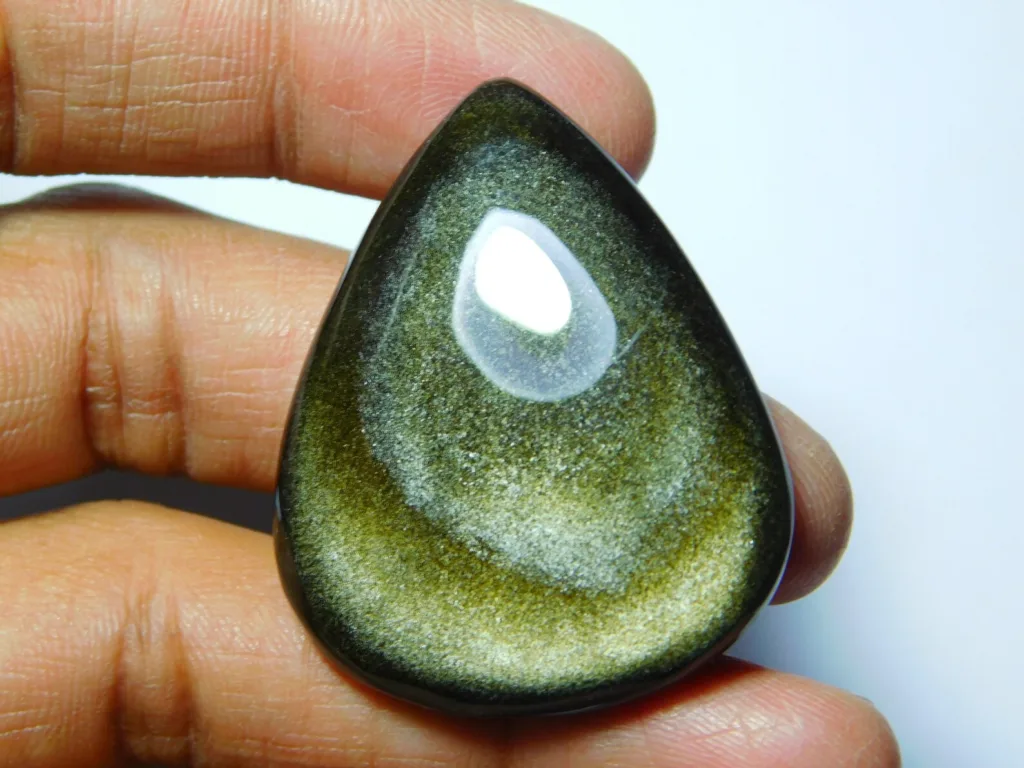
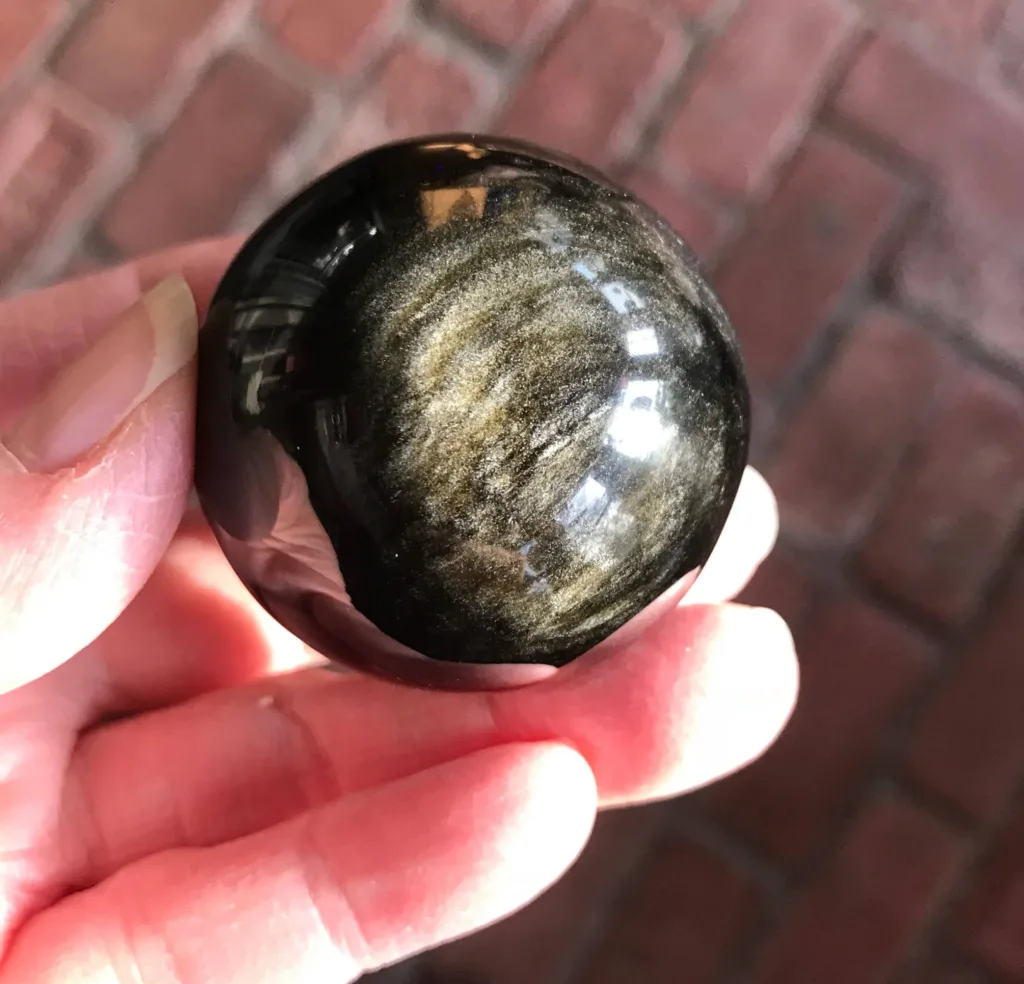
Geology and Formation of Gold Sheen Obsidian
Gold Sheen Obsidian, like other types of obsidian, is a volcanic glass that forms as a result of the rapid cooling of lava.
**1. Volcanic Origin: Originates from volcanic activity. When molten lava erupts from a volcano, it often contains a high amount of silica. As the lava flows and cools rapidly upon contact with the air or water, it solidifies into glass. Obsidian is essentially a type of natural glass.
2. Cooling Process: The key to the formation of obsidian, including Gold Sheen Obsidian, is the rapid cooling process. Unlike many other types of rocks that form through slow cooling and crystallization, obsidian lacks a crystalline structure due to its quick cooling. This results in a glassy texture.
3. Mineral Inclusions: The distinctive golden sheen in Gold Sheen Obsidian is attributed to the presence of microscopic mineral inclusions within the glass. The most common minerals responsible for the sheen are magnetite and hematite. These tiny crystals align themselves within the glass, creating the reflective and metallic appearance.
4. Composition: It is primarily composed of silicon dioxide (SiO2), the same chemical compound found in quartz. However, unlike quartz, obsidian lacks a crystalline structure because it cools too rapidly for crystals to form.
5. Colors and Variations: While Gold Sheen Obsidian is known for its golden sheen, it can also exhibit other colors such as black, brown, or green. The presence of different mineral inclusions and impurities can lead to variations in color within the obsidian.
6. Occurrence: Obsidian is found in areas with recent or ongoing volcanic activity. Deposits can be discovered near volcanic flows or in regions with a history of volcanic eruptions.
7. Use in Ancient Cultures: Throughout history, obsidian has been used by various cultures for tools, weapons, and ornaments due to its sharp edges when fractured. Gold Sheen Obsidian, with its unique appearance, may have been particularly valued for decorative and ritualistic purposes.
In summary, Gold Sheen Obsidian is a captivating variety of volcanic glass with a golden sheen, formed through the rapid cooling of lava and the inclusion of specific minerals that contribute to its unique visual appeal.
Properties and Characteristics of Gold Sheen Obsidian
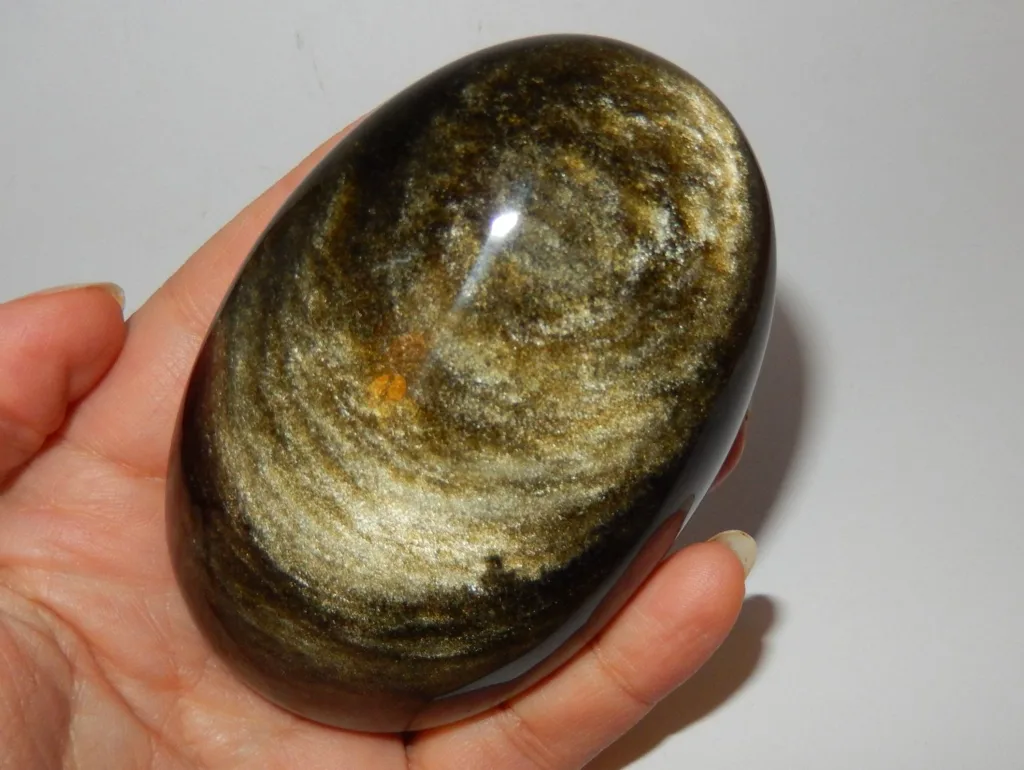
Gold Sheen Obsidian possesses several properties and characteristics that make it distinct. Here are some key features:
- Golden Sheen: The most defining characteristic of Gold Sheen Obsidian is its vibrant golden or metallic sheen. This is caused by the presence of microscopic mineral inclusions, often magnetite or hematite, within the glass.
- Color: While the primary color is a glossy black, the golden sheen adds a layer of iridescence to the surface. The combination of black and gold gives Gold Sheen Obsidian its unique and striking appearance.
- Transparency: It is generally translucent to opaque. Light can pass through the material, but it is not completely transparent.
- Luster: The luster of it is vitreous, meaning it has a glassy or shiny appearance when polished.
- Hardness: Like other types of obsidian, Gold Sheen Obsidian has a relatively high hardness. It falls between 5 and 5.5 on the Mohs scale, making it suitable for use in jewelry and carvings.
- Fracture: Obsidian, including Gold Sheen Obsidian, has a conchoidal fracture pattern. This means that when it breaks, it forms curved, shell-like fractures with sharp edges. This property has historically made obsidian a valuable material for crafting tools and weapons.
- Texture: The texture of it is smooth and glassy due to its rapid cooling process. It lacks the crystalline structure found in many other rocks.
- Density: Obsidian has a density ranging from 2.35 to 2.60 g/cm³, which is similar to that of granite.
- Formation: Gold Sheen Obsidian forms in volcanic environments when lava cools rapidly. The inclusion of specific minerals during the cooling process gives rise to the golden sheen.
- Uses: Gold Sheen Obsidian is often used for decorative purposes, such as in the creation of jewelry, carvings, and sculptures. Its unique appearance makes it a popular choice among collectors and those who appreciate gemstones.
- Spiritual Significance: Some people attribute metaphysical or spiritual properties to Gold Sheen Obsidian, believing it has protective and grounding qualities. It is thought to help deflect negative energy and promote balance.
In summary, Gold Sheen Obsidian stands out for its captivating golden sheen, making it a sought-after material for various ornamental and spiritual applications. Its unique combination of color, luster, and hardness contributes to its popularity in the world of gemstones and minerals.
Locations and Mining

Gold Sheen Obsidian is found in regions with volcanic activity where the conditions for the rapid cooling of lava are met. Here are some notable locations where Gold Sheen Obsidian can be mined:
- Mexico: Mexico is a significant source of Gold Sheen Obsidian. There are several deposits in different regions of the country, including in the states of Jalisco, Chihuahua, and Michoacán. The region around the Parícutin volcano, which experienced a notable eruption in the 1940s, is known for producing Gold Sheen Obsidian.
- United States: It can also be found in the United States. States like Oregon, California, and Arizona have deposits of obsidian, including varieties with a golden sheen. Glass Buttes in Oregon, for example, is known for producing various types of obsidian.
- Other Volcanic Regions: It may also be found in other volcanic regions around the world where conditions for the formation of obsidian are present. These areas include parts of Central and South America, as well as other regions with a history of volcanic activity.
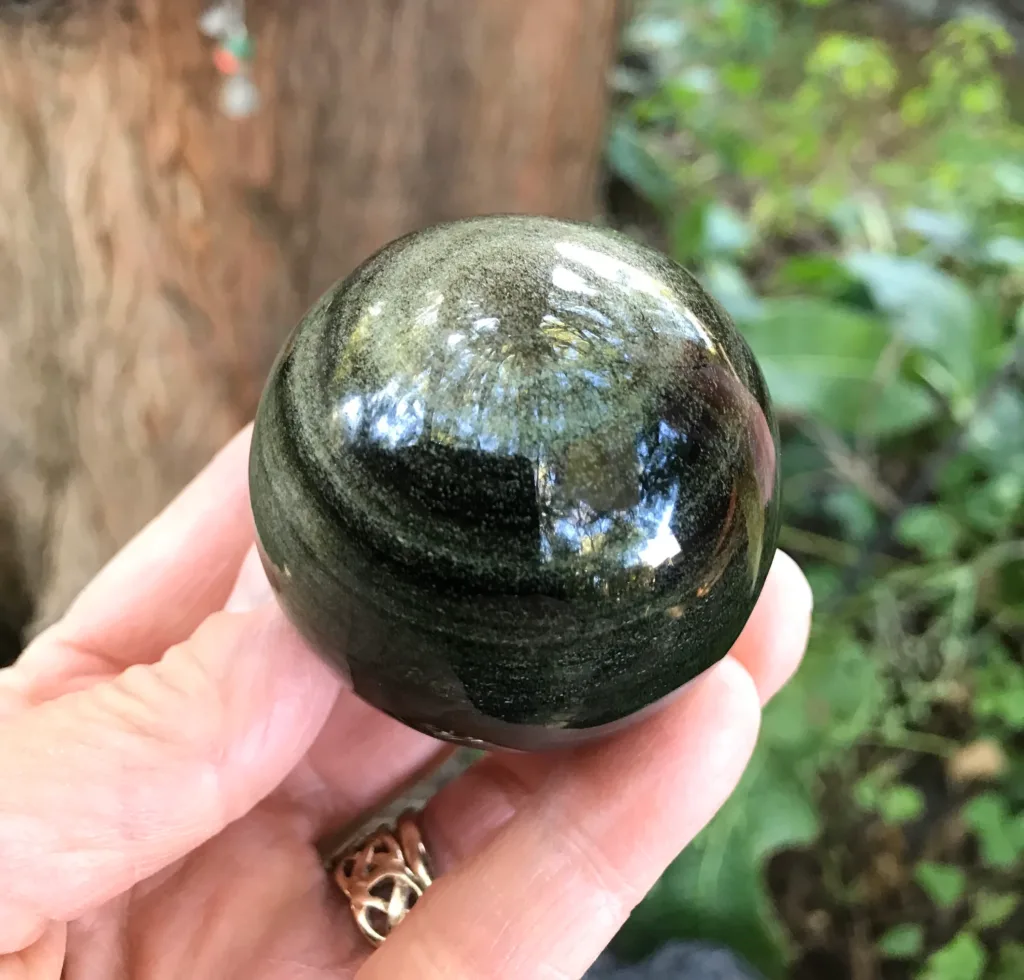
Mining Gold Sheen Obsidian involves locating and extracting the material from deposits near volcanic flows. The process typically involves the following steps:
- Exploration: Geologists and prospectors survey volcanic regions to identify areas with potential obsidian deposits. Satellite imagery and geological surveys may be used to locate promising sites.
- Extraction: Once a deposit is identified, mining operations involve the extraction of obsidian using traditional mining methods. This can include surface mining or digging into volcanic ash layers to reach the obsidian.
- Processing: Extracted obsidian is then processed to remove impurities and shape the material into usable forms. This may involve cutting, shaping, and polishing to enhance its aesthetic qualities.
- Distribution: Processed Gold Sheen Obsidian is distributed for various purposes, including the creation of jewelry, sculptures, and decorative items. It may also be sold to collectors and retailers specializing in gemstones and minerals.
It’s important to note that mining activities should be conducted responsibly to minimize environmental impact, and collectors should be aware of ethical sourcing practices when acquiring Gold Sheen Obsidian or any other gemstone.
Cultural and Historical Significance
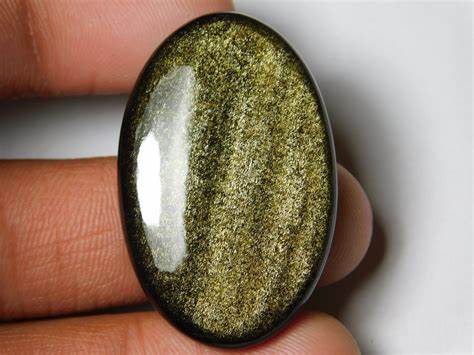
Obsidian, including Gold Sheen Obsidian, has significant cultural and historical importance across various civilizations. Here are some aspects of its cultural and historical significance:
- Toolmaking: One of the earliest uses of obsidian by humans was for toolmaking. Due to its sharp edges and conchoidal fracture pattern, obsidian was utilized by prehistoric cultures for crafting cutting tools, arrowheads, and other implements. Its use dates back thousands of years, and archaeological evidence shows that obsidian tools were widespread in regions with access to volcanic deposits.
- Ceremonial and Decorative Items: Obsidian has been used for the creation of ceremonial and decorative items in many cultures. Gold Sheen Obsidian, with its unique golden sheen, may have been particularly valued for these purposes. It has been incorporated into jewelry, sculptures, and other ornamental objects.
- Spiritual and Metaphysical Beliefs: In some cultures, obsidian is believed to have spiritual and metaphysical properties. It is often associated with protection, grounding, and the warding off of negative energy. Gold Sheen Obsidian, with its distinct appearance, may carry additional symbolic significance in spiritual practices.
- Mesoamerican Cultures: Obsidian was highly prized by Mesoamerican cultures such as the Aztecs and the Maya. These civilizations used obsidian extensively for making tools, weapons, and ritual objects. The use of obsidian blades for ceremonial bloodletting was a notable practice in Aztec culture.
- Trade and Exchange: Obsidian was an important trade item in ancient times. Due to its sharpness and utility, it was valued and traded over long distances. The movement of obsidian artifacts has been used by archaeologists to trace ancient trade routes and connections between different cultures.
- Archaeological Significance: Archaeologists use obsidian artifacts to trace the movements and interactions of ancient peoples. The chemical composition of obsidian is unique to specific volcanic sources, allowing researchers to “fingerprint” artifacts and determine their origin. This helps in understanding ancient trade networks and cultural exchanges.
- Artistic Expression: Gold Sheen Obsidian, like other varieties of obsidian, is appreciated for its aesthetic qualities. Artists and craftsmen have used it to create intricate carvings, sculptures, and jewelry, contributing to the artistic heritage of various cultures.
Understanding the cultural and historical significance of Gold Sheen Obsidian provides insights into the ways in which this unique material has been valued and utilized by different societies throughout history.
Uses and Applications of Gold Sheen Obsidian
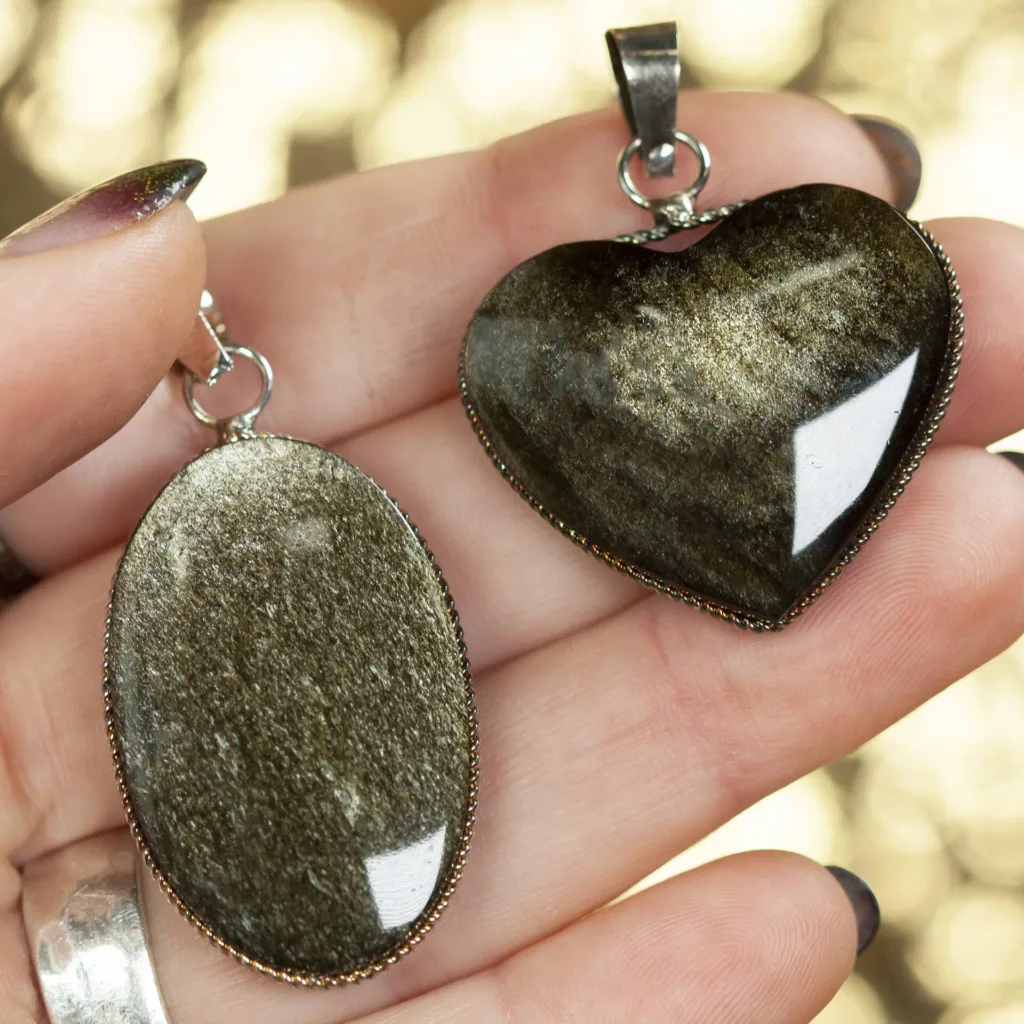
Gold Sheen Obsidian, with its unique and captivating appearance, has various uses and applications, both practical and ornamental. Here are some common ways in which Gold Sheen Obsidian is utilized:
- Jewelry: One of the most popular uses of Gold Sheen Obsidian is in the creation of jewelry. Its golden sheen adds a distinctive and elegant touch to rings, pendants, earrings, and other accessories. Craftsmen often cut and polish Gold Sheen Obsidian into cabochons or beads for use in jewelry design.
- Carvings and Sculptures: Artists and craftsmen use Gold Sheen Obsidian for carving intricate sculptures and figurines. The unique coloration and reflective properties of the golden sheen make it a sought-after material for creating decorative and artistic pieces.
- Ornamental Items: Gold Sheen Obsidian is often used to make ornamental items such as paperweights, vases, and decorative bowls. Its striking appearance makes it a popular choice for creating aesthetically pleasing objects for display.
- Ritual and Spiritual Objects: Some individuals and communities believe in the metaphysical properties of Gold Sheen Obsidian, associating it with protection and grounding. As a result, it is sometimes used for the creation of ritual objects, meditation tools, and spiritual amulets.
- Gifts and Collectibles: Due to its unique and visually appealing characteristics, Gold Sheen Obsidian is often chosen as a gift or collected by enthusiasts interested in gemstones and minerals. Collectors may acquire specimens for their beauty and rarity.
- Lapidary Art: Lapidaries, or artisans who specialize in working with gemstones and minerals, may incorporate Gold Sheen Obsidian into their creations. This can include custom-cut gemstones, inlays, and other lapidary art forms.
- Cabochons: Gold Sheen Obsidian is frequently shaped into smooth, polished cabochons, which are used in a variety of jewelry settings. Cabochons highlight the stone’s unique sheen and are commonly set in rings, earrings, and pendants.
- Knife Blades: While not as common as in ancient times, obsidian, including Gold Sheen Obsidian, is still occasionally used for crafting knife blades. The sharp edges created through knapping, a process of shaping by striking with another object, can result in extremely sharp cutting tools.
When using or acquiring Gold Sheen Obsidian, it’s essential to consider its unique properties and take proper care to maintain its appearance over time. Whether for aesthetic, spiritual, or practical purposes, Gold Sheen Obsidian continues to be valued for its distinctive qualities in various applications.




































